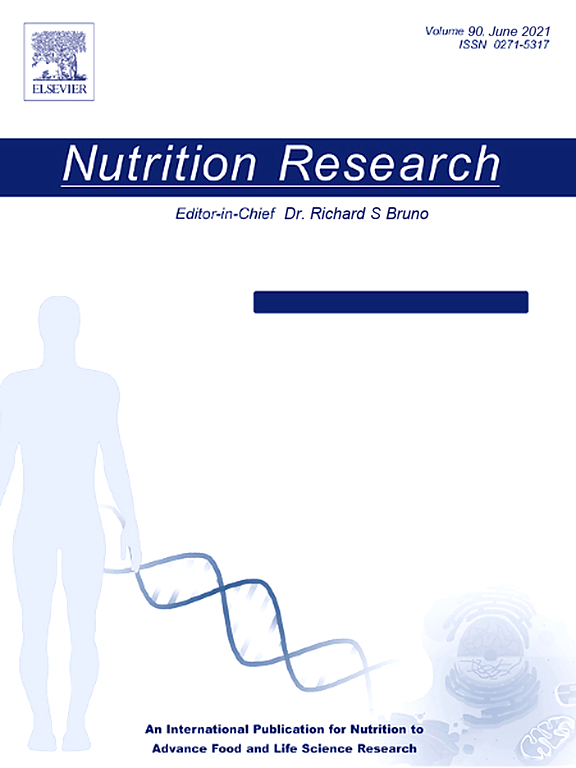孕妇和哺乳期妇女维生素C水平:与体重和吸烟负相关
IF 3.1
3区 医学
Q2 NUTRITION & DIETETICS
引用次数: 0
摘要
怀孕和哺乳被认为会增加对维生素C的需求。体重和吸烟状况也会显著影响维生素C的水平。目前研究的假设前提是孕妇和哺乳期妇女的维生素C含量低于非孕妇和哺乳期妇女,而较高的体重和吸烟会进一步影响这一点。相关数据提取自NHANES 2017-18和NHANES 2003-6数据集;这包括人口统计、生殖和人体测量变量、维生素C摄入量(膳食和补充)和血清维生素C浓度。最终合并的数据集包括3730名年龄在18-44岁之间的女性;601人(16%)确认怀孕,476人(13%)有婴儿,其中129人(27%)是母乳喂养。妊娠组维生素C摄入量及血清状态均高于非妊娠组(P <;措施)。尽管如此,大约40%的人没有摄入推荐的85毫克/天的维生素C摄入量,27%的人没有达到50µmol/L的充足维生素C水平。妊娠9个月时维生素C水平比妊娠2个月时低9µmol/L (P <;.001),尽管维生素C的摄入量增加了56毫克/天(P = .007)。维生素C水平与体重和吸烟状况呈负相关(P <;措施)。母乳喂养妇女的维生素C水平与有婴儿的非母乳喂养妇女相当(P = 0.3),尽管维生素C摄入量比母乳喂养妇女高36毫克/天(P <;措施)。研究结果表明,孕妇和哺乳期妇女,尤其是吸烟者,对维生素C的需求量更高,建议增加维生素C的摄入量,以满足目前的饮食摄入指南。本文章由计算机程序翻译,如有差异,请以英文原文为准。

Vitamin C status of pregnant and lactating women: Negative associations with body weight and current smoking
Pregnancy and lactation are believed to elevate requirements for vitamin C. Body weight and smoking status are also known significantly impact vitamin C status. The hypothesis of the current study premised that pregnant and lactating women would have lower vitamin C status than nonpregnant/nonlactating women and higher body weight and current smoking would further impact this. Relevant data was extracted from NHANES 2017-18 and NHANES 2003-6 datasets; this included demographic, reproductive and anthropometric variables, vitamin C intake (dietary and supplemental) and serum vitamin C concentrations. The final combined dataset comprised 3730 women aged 18-44 years; 601 (16%) were confirmed pregnant and 476 (13%) had infants, of whom 129 (27%) were breastfeeding. The vitamin C intake and serum status of the pregnant group was higher than the nonpregnant group (P < .001). Despite this, approximately 40% were not consuming the recommended vitamin C intake of 85 mg/d and 27% did not achieve adequate vitamin C status of 50 µmol/L. Vitamin C status was 9 µmol/L lower at nine months relative to two months of pregnancy (P < .001), despite a 56 mg/d higher vitamin C intake (P = .007). Vitamin C status was negatively associated with body weight and smoking status (P < .001). Breastfeeding woman had comparable vitamin C status to nonbreastfeeding women with infants (P = .3), despite a 36 mg/d higher vitamin C intake (P < .001). The results indicate that pregnant and lactating women, particularly smokers, have higher requirements for vitamin C and are recommended to increase their vitamin C intakes to meet current dietary intake guidelines.
求助全文
通过发布文献求助,成功后即可免费获取论文全文。
去求助
来源期刊

Nutrition Research
医学-营养学
CiteScore
7.60
自引率
2.20%
发文量
107
审稿时长
58 days
期刊介绍:
Nutrition Research publishes original research articles, communications, and reviews on basic and applied nutrition. The mission of Nutrition Research is to serve as the journal for global communication of nutrition and life sciences research on diet and health. The field of nutrition sciences includes, but is not limited to, the study of nutrients during growth, reproduction, aging, health, and disease.
Articles covering basic and applied research on all aspects of nutrition sciences are encouraged, including: nutritional biochemistry and metabolism; metabolomics, nutrient gene interactions; nutrient requirements for health; nutrition and disease; digestion and absorption; nutritional anthropology; epidemiology; the influence of socioeconomic and cultural factors on nutrition of the individual and the community; the impact of nutrient intake on disease response and behavior; the consequences of nutritional deficiency on growth and development, endocrine and nervous systems, and immunity; nutrition and gut microbiota; food intolerance and allergy; nutrient drug interactions; nutrition and aging; nutrition and cancer; obesity; diabetes; and intervention programs.
 求助内容:
求助内容: 应助结果提醒方式:
应助结果提醒方式:


